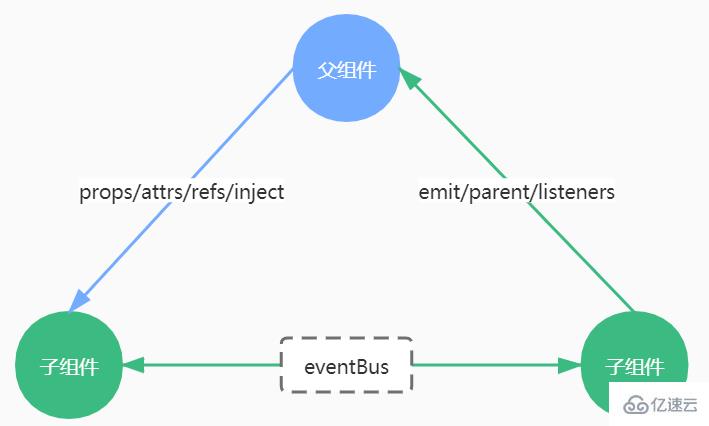您好,登錄后才能下訂單哦!
您好,登錄后才能下訂單哦!
這篇文章主要介紹“vue組件如何傳值”的相關知識,小編通過實際案例向大家展示操作過程,操作方法簡單快捷,實用性強,希望這篇“vue組件如何傳值”文章能幫助大家解決問題。
傳值方法:1、利用props實現父傳子;2、子傳父,需要自定義事件,在子組件中用“this.$emit(‘事件名’)”觸發,而父中用“@事件名”監聽;3、兄弟間,通過公有父元素作為橋接,結合父子props傳參、子父自定義事件;4、用路由傳值;5、用$ref傳值;6、用依賴注入傳給后代子孫曾孫;7、利用$attrs;8、借助$listeners中間事件;9、用$parent傳等。
vue組件傳值的10種方式,常用的也有五六種,先上一張總結圖:

在子組件里定義一個props,即props:[‘msg’],msg可以是對象也可以是基本數據類型
如果你想定義一個默認值,即 props:{msg: {type: String, default: ‘hello world’}},
若默認值是對象類型:props: { msg: { type: Object, default: () => { return { name: ‘dan_seek’ } } }}
需要注意的是這種傳值是單向的,你無法改變父組件的值(當然引用類型例外);而且如果直接修改props的值會報一個警告。
推薦的寫法是在data()里重新定義一個變量(見Children.vue),并把props賦值給它,當然計算屬性也行。
Children.vue
<template>
<section>
父組件傳過來的消息是:{{myMsg}}
</section>
</template>
<script>
export default {
name: "Children",
components: {},
props:['msg'],
data() {
return {
myMsg:this.msg
}
},
methods: {}
}
</script>
Parent.vue
<template>
<div class="parent">
<Children :msg="message"></Children>
</div>
</template>
<script>
import Children from '../components/Children'
export default {
name: 'Parent',
components: {
Children
},
data() {
return {
message:'hello world'
}
},
}
</script>
這里需要使用自定義事件,在子組件中使用this.$emit(‘myEvent’) 觸發,然后在父組件中使用@myEvent監聽
Children.vue
<template>
<div class="parent">
這里是計數:{{parentNum}}
<Children-Com @addNum="getNum"></Children-Com>
</div>
</template>
<script>
import ChildrenCom from '../components/Children'
export default {
name: 'Parent',
components: {
ChildrenCom
},
data() {
return {
parentNum: 0
}
},
methods:{
// childNum是由子組件傳入的
getNum(childNum){
this.parentNum = childNum
}
}
}
</script>
Parent.vue
<template>
<div class="parent">
這里是計數:{{parentNum}}
<Children-Com @addNum="getNum"></Children-Com>
</div></template><script>
import ChildrenCom from '../components/Children'
export default {
name: 'Parent',
components: {
ChildrenCom },
data() {
return {
parentNum: 0
}
},
methods:{
// childNum是由子組件傳入的
getNum(childNum){
this.parentNum = childNum }
}
}</script>
運用自定義事件emit的觸發和監聽能力,定義一個公共的事件總線eventBus,通過它作為中間橋梁,我們就可以傳值給任意組件了。而且通過eventBus的使用,可以加深emit的理解。
EventBus.js
import Vue from 'vue'
export default new Vue()
Children1.vue
<template>
<section>
<div @click="pushMsg">push message</div>
<br>
</section>
</template>
<script>
import eventBus from './EventBus'
export default {
name: "Children1",
components: {},
data() {
return {
childNum:0
}
},
methods: {
pushMsg(){
// 通過事件總線發送消息
eventBus.$emit('pushMsg',this.childNum++)
}
}
}
</script>
Children2.vue
<template>
<section>
children1傳過來的消息:{{msg}}
</section>
</template>
<script>
import eventBus from './EventBus'
export default {
name: "Children2",
components: {},
data() {
return {
msg: ''
}
},
mounted() {
// 通過事件總線監聽消息
eventBus.$on('pushMsg', (children1Msg) => {
this.msg = children1Msg
})
}
}
</script>
Parent.vue
<template>
<div class="parent">
<Children1></Children1>
<Children2></Children2>
</div>
</template>
<script>
import Children1 from '../components/Children1'
import Children2 from '../components/Children2'
export default {
name: 'Parent',
components: {
Children1,
Children2
},
data() {
return {
}
},
methods:{
}
}
</script>
github上還有一個開源vue-bus庫,可以參考下: https://github.com/yangmingshan/vue-bus#readme
i.使用問號傳值
A頁面跳轉B頁面時使用 this.$router.push(‘/B?name=danseek’)
B頁面可以使用 this.$route.query.name 來獲取A頁面傳過來的值
上面要注意router和route的區別
ii.使用冒號傳值
配置如下路由:
{
path: '/b/:name',
name: 'b',
component: () => import( '../views/B.vue')
},
在B頁面可以通過 this.$route.params.name 來獲取路由傳入的name的值
iii.使用父子組件傳值
由于router-view本身也是一個組件,所以我們也可以使用父子組件傳值方式傳值,然后在對應的子頁面里加上props,因為type更新后沒有刷新路由,所以不能直接在子頁面的mounted鉤子里直接獲取最新type的值,而要使用watch。
<router-view :type="type"></router-view>
// 子頁面
......
props: ['type']
......
watch: {
type(){
// console.log("在這個方法可以時刻獲取最新的數據:type=",this.type)
},
},
通過$ref的能力,給子組件定義一個ID,父組件通過這個ID可以直接訪問子組件里面的方法和屬性
首先定義一個子組件Children.vue
<template>
<section>
傳過來的消息:{{msg}}
</section>
</template>
<script>
export default {
name: "Children",
components: {},
data() {
return {
msg: '',
desc:'The use of ref'
}
},
methods:{
// 父組件可以調用這個方法傳入msg
updateMsg(msg){
this.msg = msg
}
},
}
</script>
然后在父組件Parent.vue中引用Children.vue,并定義ref屬性
<template>
<div class="parent">
<!-- 給子組件設置一個ID ref="children" -->
<Children ref="children"></Children>
<div @click="pushMsg">push message</div>
</div>
</template>
<script>
import Children from '../components/Children'
export default {
name: 'parent',
components: {
Children,
},
methods:{
pushMsg(){
// 通過這個ID可以訪問子組件的方法
this.$refs.children.updateMsg('Have you received the clothes?')
// 也可以訪問子組件的屬性
console.log('children props:',this.$refs.children.desc)
}
},
}
</script>
假設父組件有一個方法 getName(),需要把它提供給所有的后代
provide: function () {
return {
getName: this.getName()
}
}
provide 選項允許我們指定我們想要提供給后代組件的數據/方法
然后在任何后代組件里,我們都可以使用 inject 來給當前實例注入父組件的數據/方法:
inject: ['getName']
Parent.vue
<template>
<div class="parent">
<Children></Children>
</div>
</template>
<script>
import Children from '../components/Children'
export default {
name: 'Parent',
components: {
Children,
},
data() {
return {
name:'dan_seek'
}
},
provide: function () {
return {
getName: this.name
}
},
}
</script>
Children.vue
<template>
<section>
父組件傳入的值:{{getName}}
</section>
</template>
<script>
export default {
name: "Children",
components: {},
data() {
return {
}
},
inject: ['getName'],
}
</script>
正常情況下需要借助父親的props作為中間過渡,但是這樣在父親組件就會多了一些跟父組件業務無關的屬性,耦合度高,借助$attrs可以簡化些,而且祖跟孫都無需做修改
GrandParent.vue
<template>
<section>
<parent name="grandParent" sex="男" age="88" hobby="code" @sayKnow="sayKnow"></parent>
</section>
</template>
<script>
import Parent from './Parent'
export default {
name: "GrandParent",
components: {
Parent
},
data() {
return {}
},
methods: {
sayKnow(val){
console.log(val)
}
},
mounted() {
}
}
</script>
Parent.vue
<template>
<section>
<p>父組件收到</p>
<p>祖父的名字:{{name}}</p>
<children v-bind="$attrs" v-on="$listeners"></children>
</section>
</template>
<script>
import Children from './Children'
export default {
name: "Parent",
components: {
Children
},
// 父組件接收了name,所以name值是不會傳到子組件的
props:['name'],
data() {
return {}
},
methods: {},
mounted() {
}
}
</script>
Children.vue
<template>
<section>
<p>子組件收到</p>
<p>祖父的名字:{{name}}</p>
<p>祖父的性別:{{sex}}</p>
<p>祖父的年齡:{{age}}</p>
<p>祖父的愛好:{{hobby}}</p>
<button @click="sayKnow">我知道啦</button>
</section>
</template>
<script>
export default {
name: "Children",
components: {},
// 由于父組件已經接收了name屬性,所以name不會傳到子組件了
props:['sex','age','hobby','name'],
data() {
return {}
},
methods: {
sayKnow(){
this.$emit('sayKnow','我知道啦')
}
},
mounted() {
}
}
</script>
父組件收到
祖父的名字:grandParent
子組件收到
祖父的名字:
祖父的性別:男
祖父的年齡:88
祖父的愛好:code
借助$listeners中間事件,孫可以方便的通知祖,代碼示例見7
通過parent可以獲父組件實例,然后通過這個實例就可以訪問父組件的屬性和方法,它還有一個兄弟root,可以獲取根組件實例。
語法:
// 獲父組件的數據
this.$parent.foo
// 寫入父組件的數據
this.$parent.foo = 2
// 訪問父組件的計算屬性
this.$parent.bar
// 調用父組件的方法
this.$parent.baz()
于是,在子組件傳給父組件例子中,可以使用this.$parent.getNum(100)傳值給父組件。
sessionStorage 是瀏覽器的全局對象,存在它里面的數據會在頁面關閉時清除 。運用這個特性,我們可以在所有頁面共享一份數據。
語法:
// 保存數據到 sessionStorage
sessionStorage.setItem('key', 'value');
// 從 sessionStorage 獲取數據
let data = sessionStorage.getItem('key');
// 從 sessionStorage 刪除保存的數據
sessionStorage.removeItem('key');
// 從 sessionStorage 刪除所有保存的數據
sessionStorage.clear();
注意:里面存的是鍵值對,只能是字符串類型,如果要存對象的話,需要使用 let objStr = JSON.stringify(obj) 轉成字符串然后再存儲(使用的時候 let obj = JSON.parse(objStr) 解析為對象)。
這樣存對象是不是很麻煩呢,推薦一個庫 good-storage ,它封裝了sessionStorage ,可以直接用它的API存對象
// localStorage
storage.set(key,val)
storage.get(key, def)
// sessionStorage
storage.session.set(key, val)
storage.session.get(key, val)
關于“vue組件如何傳值”的內容就介紹到這里了,感謝大家的閱讀。如果想了解更多行業相關的知識,可以關注億速云行業資訊頻道,小編每天都會為大家更新不同的知識點。
免責聲明:本站發布的內容(圖片、視頻和文字)以原創、轉載和分享為主,文章觀點不代表本網站立場,如果涉及侵權請聯系站長郵箱:is@yisu.com進行舉報,并提供相關證據,一經查實,將立刻刪除涉嫌侵權內容。